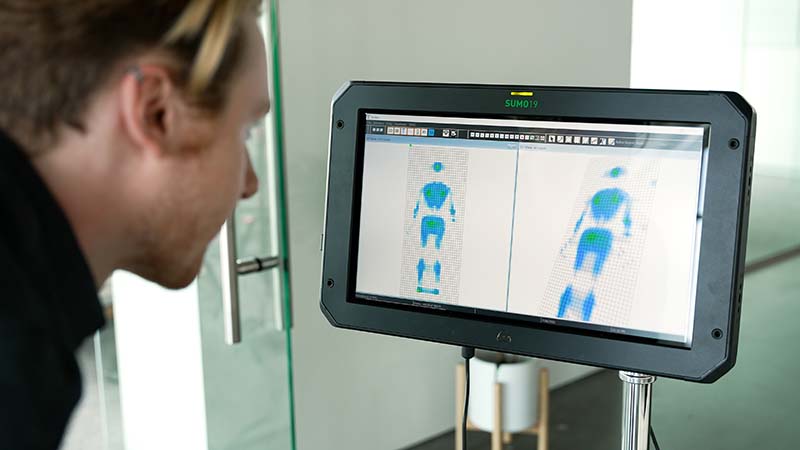Pressure Relief
At some point or another, sleepers may experience painful pressure points where certain body parts dig into the sleep surface. You may notice that some mattresses lead to pressure points no matter how much you toss and turn, while others seem to reduce these uncomfortable spots. The ability to redistribute weight to reduce pressure buildup is referred to as pressure relief, and it varies from model to model.
Our goal at the Test Lab is to help take the guesswork out of mattress shopping. Understanding a mattress’ materials and design can tell you more about its pressure-relieving capabilities. Our testing team also runs a series of evaluations on each model to analyze its performance.
Pressure relief is highly dependent on your body type and sleeping position, so no single mattress is optimal for every sleeper. However, certain models tend to perform better in this area, and you can narrow down your options by understanding what you need in a mattress. We’ll take an in-depth look at how pressure relief works and explain what you need to know to find the best mattress for you.
What is Pressure Relief?
Mattresses that evenly disperse body weight and prevent sore spots are said to relieve pressure. Pressure relief is strongly tied to mattress firmness, and most sleepers find models with some contouring ideal. As the comfort system molds itself around the curves of the body, it helps reduce the force around common contact areas, such as the shoulders and hips. Our Test Lab reviews pressure relief by measuring the amount of pressure on these high-tension areas.


Pressure relief is often linked with cushioning, but it involves a greater element of spinal support. A mattress that fails to keep the spine on an even plane can lead to tension in critical areas, such as the lower back. Ideally, you should sink into the mattress’ comfort system and receive progressively firmer support from the layers below.
Advanced models sometimes incorporate zoning, meaning the bed is firmer in some areas and softer in others. These designs are intended to lift the areas of the body that typically need more support and cushion common pressure points.
The overall perceived comfort of a mattress is largely dependent on pressure relief since it affects tension, impact, and spinal alignment.
Who Should Care About Pressure Relief?
Pressure relief is one of the most important features of a mattress, but it may be even more critical for athletes and people who live with chronic pain. However, the correct balance of pressure relief and support can look different depending on your body type and your preferred sleeping position.
Side sleepers and individuals who weigh less than 130 pounds often suffer from sharp pressure points and may require a softer mattress. For sleepers under 130 pounds, this is because they place minimal force on the surface, making it feel firmer.
On the other hand, side sleeping places extra pressure on the hips and shoulders, which can quickly lead to soreness if there is insufficient cushioning. Usually, the best mattresses for side sleepers have thicker comfort systems that allow wider parts of the body to sink in enough for the spine to remain straight.
Back sleeping naturally aligns the spine, so individuals who prefer this position generally do best on a surface with a balanced feel. The largest concern for back sleepers is the lower back, which can suffer from pressure buildup if the hips and lumbar region do receive enough support.
Individuals over 230 pounds and those who prefer sleeping on their stomachs require a firmer surface to maintain spinal alignment. Stomach sleeping doesn’t tend to cause pressure points in the traditional sense, but it can lead to improper spinal alignment and lower back discomfort if the sleeper’s midsection sinks in too far.
Mattress Materials and Pressure Relief
Pressure relief is determined primarily by the materials, construction, and how the components work together.
Most mattresses contain two primary sections: the comfort system and the support core. The comfort system is closest to the sleeper, consisting of one or more layers designed to cushion the body. The support core typically contains firmer materials engineered to provide a stable base and promote spinal alignment.
Because the comfort system comes into more direct contact with the sleeper, this is the first place to look if you want an idea of how a mattress will feel. Thicker comfort systems tend to contour more deeply. Common materials for comfort layers include memory foam, polyfoam, latex, and microcoils.
| Material | Description | Feel | Pressure Relief Performance |
|---|---|---|---|
| Memory Foam | Memory foam is a type of foam with enhanced viscosity and elasticity. This means it changes shape in response to heat and pressure and gradually returns to its original form when pressure is lifted. | Despite being relatively dense, memory foam contours closely to the body. Sleepers generally sink in, which creates a feeling that many liken to a hug. | Memory foam typically excels at pressure relief by molding the body in response to its weight and heat. That said, the material takes a few seconds to adjust to a new shape, which may cause fleeting pressure points when switching positions. |
| Polyfoam | A synthetic material manufactured from petrochemicals, polyfoam can be treated in many different ways that change the way it feels and performs. Denser polyfoam is suitable for use in the support core or transitional layer, but many mattresses also use lower-density polyfoam in their comfort systems. | Polyfoam can take on different properties depending on its formulation. It is usually quicker to regain its shape and less prone to heat retention than memory foam, but it doesn’t conform as closely to the body. | Polyfoam contours more gently than memory foam. This makes it suitable for sleepers who want some level of pressure relief without much hugging sensation. This material can also be zoned for targeted pressure relief. |
| Latex | Latex can be manufactured synthetically of petrochemicals or naturally with the sap of rubber trees, which is processed using the Talalay method or the Dunlop method. Talalay latex is characterized by its springy, homogenous feel, whereas Dunlop latex is generally denser, particularly on one side. | Latex is quite resilient and tends to sleep cool. The material contours evenly, albeit without the close hug of memory foam. Latex is highly durable and can appear in the comfort or support layers. | Because it conforms less closely, latex generally doesn’t relieve pressure to the same extent as memory foam or polyfoam. Talalay latex tends to be plusher and might be more suitable for side sleepers and those under 130 pounds. |
| Microcoils | Microcoils are steel springs measuring 1 to 3 inches in height. As with pocketed coils, each spring is usually individually wrapped in fabric and designed to compress without affecting its neighboring coils. | Mattresses that use microcoils typically include them in the comfort or transition layer to add responsive contouring. Incorporating a layer of microcoils can also increase bounce and airflow. | Microcoils help provide indirect pressure relief. Since they generally move independently of one another, they can supply proportionate support for different parts of the body. Combined with an additional comfort layer for cushioning, microcoils often contribute to notable pressure relief. |
Pressure Relief by Mattress Type
Based on the materials used in the support core, most models can be categorized as either all-foam, latex, hybrid, innerspring, or airbed. The support core has less of a direct influence on pressure relief, but it can still contribute to an extent.
Foam: High-density polyfoam support cores help prevent sleepers from sinking too far into the mattress. Some softer all-foam models fail to adequately support sleepers over 230 pounds, which may lead to excessive sinkage in weight-bearing areas with corresponding pressure buildup.
Latex: Latex mattresses tend to be durable and supportive. Although they don’t offer localized contouring, they can help reduce potential pressure points from improper spinal alignment by limiting sinkage.
Hybrid: Made with thick comfort systems over coil support cores, hybrid mattresses aim to leverage the advantages of multiple types of beds. Hybrids usually provide average to above-average pressure relief depending on the composition of the comfort system. Most models use pocketed coil systems that compress directly under pressure, forming a deep cradle. Pocketed coil cores are also frequently zoned for more precise support and relief.
Innerspring: Most innerspring models are built with interconnected coils that move as a unit, so they usually lack targeted support. Moreover, as their comfort systems are thin to nonexistent, innerspring mattresses usually provide little to no pressure relief.
Airbed: Airbeds with thick, cushioning comfort layers often have strong pressure relief. The firmness of the bed is also adjustable by filling or emptying the air chamber core, allowing sleepers to choose the feel that works best for their needs.
How Do We Test for Pressure Relief?
Pressure relief is one of the first things we evaluate when analyzing a new mattress. Our team members test the bed by lying on it and measuring pressure buildup using a pressure mapping pad. These assessments help us gauge how the mattress performs compared to other models of the same type.

Body Testing
To test how a mattress feels, our in-house testers lie on the bed in different positions and record their perceptions.
Each tester starts by lying on their side for 3 minutes, leaving enough time for pressure points to form. Then, they get off the bed and note any pressure points they experienced as well as their overall impressions. Once the mattress regains its original shape, each tester repeats the process on their back, stomach, and other side.
Body testing has an element of subjectivity. For example, a mattress might provide excellent pressure relief for a sleeper over 230 pounds but minimal relief for someone under 130 pounds. Our testing team includes individuals of varying body types and preferred sleeping positions to capture the experience of a wider range of sleepers. Every tester assesses multiple mattresses so that we have consistent ratings from model to model.
A mattress with zoning or reinforced edge support might offer different levels of pressure relief in different areas. For a fairer trial, we have our testers lie in the same spot on every model. We also use a reinforced foundation so that the mattress has the chance to perform at its best.
Pressure Map Testing
Whereas body testing illustrates the human experience of lying on the bed, pressure map testing allows us to gain measurable data about pressure points. In these tests, the same sleepers repeat the process of lying on their backs, stomachs, and both sides. However, this time, we place a pressure pad between the tester and the mattress.
The pressure map provides a visual overview of where pressure is concentrated. It’s natural for a mattress to display some pressure points, particularly when sleepers lie on their sides. That said, an excessive concentration of pressure in a given area may indicate that the mattress is not suitable for that type of sleeper.
We control the variables by using the same testers from the body testing trials and having them lie in the same spots on each mattress, allowing time between positions for any body impressions to clear. We lay the pressure mapping tool in the same position on every mattress and use the same settings to stay consistent across evaluations.
Learn more about the Test Lab at the link below.

Frequently Asked Questions About Pressure Relief
Can I improve my bed’s pressure relief?
There are several ways to improve your bed’s pressure relief. Since pressure relief encompasses proper support as well as cushioning, the best method depends on your individual needs.
The easiest way to improve your bed’s pressure relief is to add a mattress topper. Mattress toppers change the feel of the bed by adding a layer of cushioning. If your mattress has adjustable firmness options, this offers another opportunity to customize the feel. Adjustable firmness is common in airbeds and flippable models with a different firmness on either side.
Checking your bed frame or foundation to ensure it’s providing solid, even support for your mattress is also important. A flimsy or uneven foundation can cause the mattress to sag, leading to pressure points from poor spinal support.
What type of mattress is best for pressure relief?
The best type of mattress for pressure relief depends on your weight, your preferred sleeping position, and whether you have any extra-sensitive areas. Foam mattresses and hybrid models with thick comfort systems tend to offer the most cushioning, making them a popular choice with sleepers who value pressure relief. Stomach sleepers or those who weigh over 230 pounds may be more comfortable on a latex mattress or a model with zoned support.
How does pressure relief impact other mattress performance factors?
Pressure-relieving mattresses also tend to perform well at motion isolation, which may be advantageous for sensitive sleepers who share the bed. On the other hand, close-conforming materials may trap heat and limit movement on top of the bed. You’ll need to consider which factors are most important to you when selecting a mattress.

